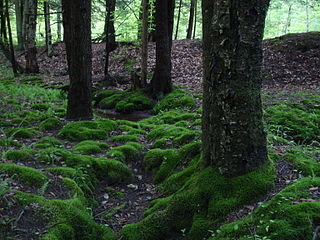
Mosses, the taxonomic division Bryophyta or the bryophytes, are small, non-vascular flowerless plants that typically form dense green clumps or mats, often in damp or shady locations. The individual plants are usually composed of simple leaves that are generally only one cell thick, attached to a stem that may be branched or unbranched and has only a limited role in conducting water and nutrients. Although some species have conducting tissues, these are generally poorly developed and structurally different from similar tissue found in vascular plants. Mosses do not have seeds and after fertilisation develop sporophytes with unbranched stalks topped with single capsules containing spores. They are typically 0.2–10 cm (0.1–3.9 in) tall, though some species are much larger. Dawsonia, the tallest moss in the world, can grow to 50 cm (20 in) in height.
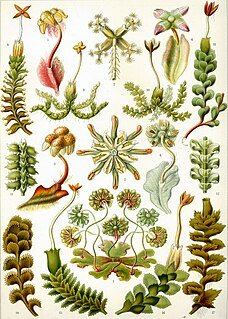
The Marchantiophyta are a division of non-vascular land plants commonly referred to as hepatics or liverworts. Like mosses and hornworts, they have a gametophyte-dominant life cycle, in which cells of the plant carry only a single set of genetic information.
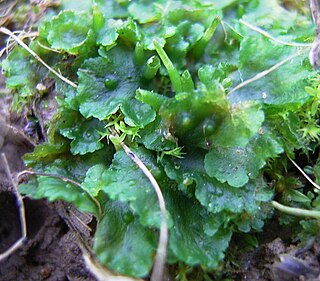
Hornworts are a group of bryophytes constituting the division Anthocerotophyta. The common name refers to the elongated horn-like structure, which is the sporophyte. As in mosses and liverworts, the flattened, green plant body of a hornwort is the gametophyte plant.

Marchantiales is an order of thallose liverworts that includes species like Marchantia polymorpha, a widespread plant often found beside rivers, and Lunularia cruciata, a common and often troublesome weed in moist, temperate gardens and greenhouses.

Lunularia cruciata, the crescent-cup liverwort, is a liverwort of the order Marchantiales, and the only species in the genus Lunularia and family Lunulariaceae. The name, from Latin luna, moon, refers to the moon-shaped gemmacups.
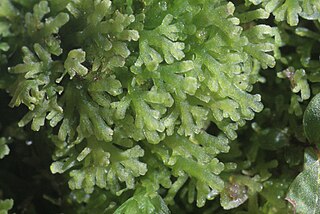
Metzgeriales is an order of liverworts. The group is sometimes called the simple thalloid liverworts: "thalloid" because the members lack structures resembling stems or leaves, and "simple" because their tissues are thin and relatively undifferentiated. All species in the order have a small gametophyte stage and a smaller, relatively short-lived, spore-bearing stage. Although these plants are almost entirely restricted to regions with high humidity or readily available moisture, the group as a whole is widely distributed, and occurs on every continent except Antarctica.

Riccia is a genus of liverworts in the order Marchantiales.
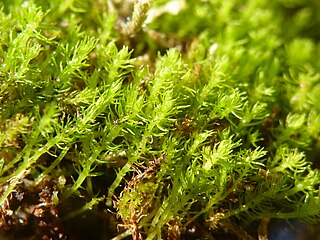
Takakia is a genus of two species of mosses known from western North America and central and eastern Asia. The genus is placed as a separate family, order and class among the mosses. It has had a history of uncertain placement, but the discovery of sporophytes clearly of the moss-type firmly supports placement with the mosses.

Jungermanniopsida is the largest of three classes within the division Marchantiophyta (liverworts).

Cavicularia densa is the only species in the liverwort genus Cavicularia. The species was first described in 1897 by Franz Stephani, and is endemic to Japan, where it grows on fine moist soil.
Pallaviciniaceae is a widely distributed family of liverworts in the order Pallaviciniales. All species are thallose, typically organized as a thick central costa (midvein), each side with a broad wing of tissue one cell in thickness. All species are dioicous. The greatest diversity is in Australasia, with some species endemic to that region, though species belonging to the family may be found on every continent except Antarctica.

Haplomitriopsida is a newly recognized class of liverworts comprising fifteen species in three genera. Recent cladistic analyses of nuclear, mitochondrial, and plastid gene sequences place this monophyletic group as the basal sister group to all other liverworts. The group thus provides a unique insight into the early evolution of liverworts in particular and of land plants in general.

Pellia epiphylla is a species of thallose liverwort. It occurs in North America, Europe, North Africa and parts of Asia. It grows in patches in damp, sheltered places on neutral or acidic substrates. It is common on the banks of rivers, streams and ditches and also grows in wet woodland, marshes and on wet rocks.
Jensenia spinosa is a dioicous bryophyte plant in the liverwort family Pallaviciniaceae. It is the only African member of the genus Jensenia, and generally occurs at high elevations. It is widespread but scarce, and has been found in South Africa, Malawi, Tanzania, Rwanda, the Democratic Republic of the Congo, as well as the islands of Mauritius, Réunion and Saint Helena.
Petalophyllum ralfsii, the petalwort, is a liverwort of the order Fossombroniales. It is a small green bryophyte that occurs in the Mediterranean region as far east as Turkey, and along the Atlantic coast of Europe as far as northwest Scotland. It grows primarily on moist sand dunes.

Marchantia berteroana is a liverwort species in the genus Marchantia.
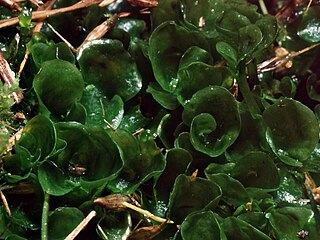
Pallaviciniales is an order of liverworts.
Petalophyllum, or petalwort, is a genus of liverworts in the order Fossombroniales.
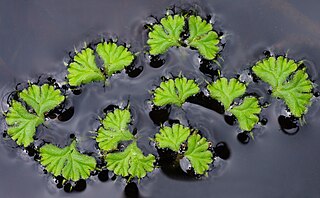
Ricciocarpos natans is the only species in the genus Ricciocarpos, a genus of liverworts in the family Ricciaceae. It was formerly listed in 1759 as a species of Riccia by Linnaeus, but then assigned to a new genus of its own in 1829 by August Carl Joseph Corda.

Asterella californica is a complex thallic liverwort in the phylum Marchantiophyta. A. californica often grows as colonies of flat rosettes of light green, rigid thalli, with undersides dark wine-red to nearly black. The receptacles are rounded, with four lobes each bearing a single sporangium sheathed by a white tattered skirt. A. californica is dioecious with separate male plants often intermingled with female plants. This species is found throughout California from San Francisco southward to San Diego and Guadalupe Island. Asterella californica is the commonest species of the three species of Asterella occurring in California; the other two species are A. bolanderi and A. palmeri.
















